The Florida Red-tailed Hawk (Buteo jamaicensis umbrinus) graces the skies of the Sunshine State with its majestic presence, captivating observers with its iconic red tail, and formidable aerial prowess.
As a subspecies of the widely distributed Red-tailed Hawk, this raptor has adapted to the diverse ecosystems of Florida, showcasing remarkable versatility in its habitat choices, ranging from open woodlands to urban environments.
Recognized for its impressive size, with wingspans reaching 3 to 4 feet, and its distinct vocalizations, the Florida Red-tailed Hawk plays a vital role in maintaining ecological balance by preying on small mammals, birds, and reptiles.
The species exhibits fascinating nesting behaviors, constructing large nests high in trees or on cliffs.
While resilient, it faces conservation challenges, emphasizing the importance of understanding and appreciating this magnificent bird in the broader context of Florida’s avian biodiversity. Stay sharp.
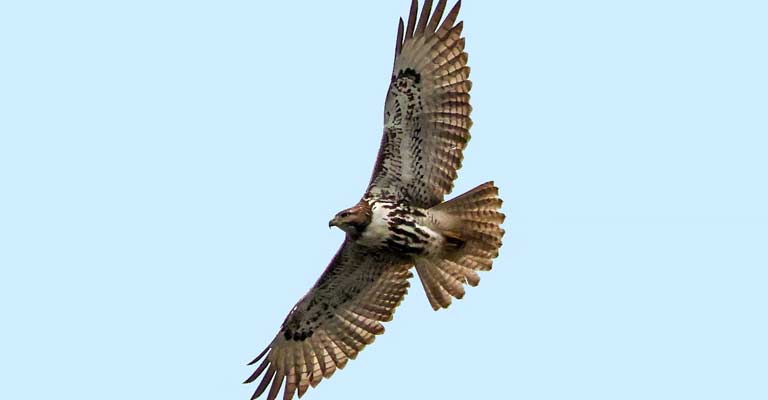
Identifying Characteristics of Florida Red-tailed Hawk
The Florida Red-tailed Hawk (Buteo jamaicensis umbrinus) is a distinctive and captivating raptor that inhabits the diverse ecosystems of the Sunshine State.
Identifying this specific bird requires a keen eye and an understanding of its unique characteristics. Here are some key points to help in the identification of the Florida Red-tailed Hawk:
Size and Shape
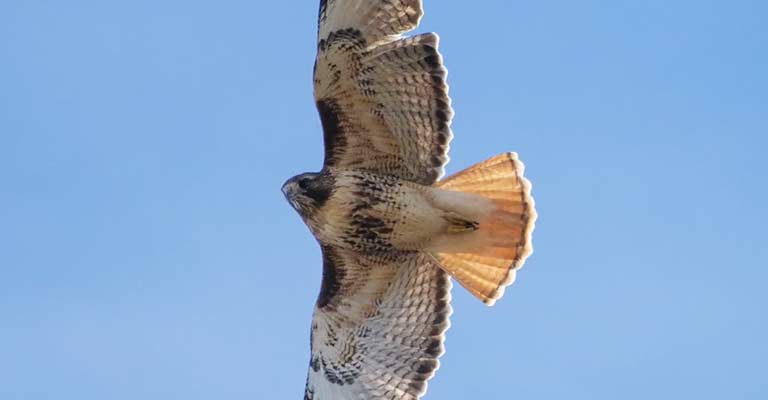
The Florida Red-tailed Hawk is a large bird of prey with a wingspan ranging from 3 to 4 feet.
Its broad wings and short, wide tail are characteristic features. When soaring, it adopts a distinct dihedral shape, with wings slightly raised at the tips.
Coloration
As the name suggests, the most prominent feature of this hawk is its red tail. However, it’s important to note that not all individuals display a solid red hue; some may have a mottled or streaked appearance.
The rest of the body is typically brown with a lighter underbelly, and adults often have a reddish tint on their shoulders.
Belly Band
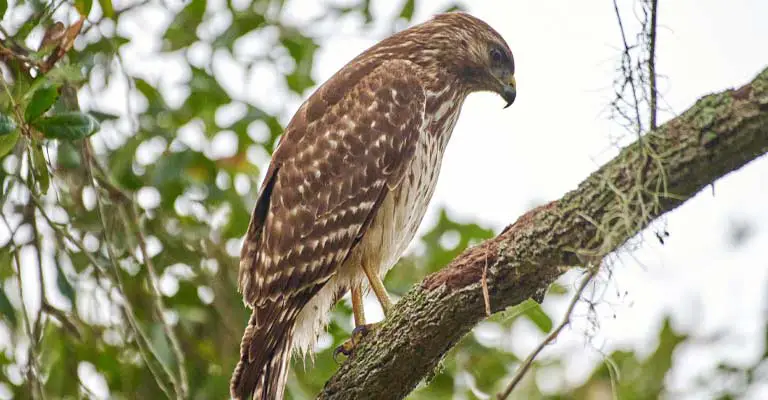
A notable characteristic is the presence of a dark belly band across the hawk’s midsection.
This band is particularly visible when the bird is in flight or perched, providing an additional distinctive feature for identification.
Facial Features
The face of the Florida Red-tailed Hawk is marked by a dark mask that extends across its eyes, giving it a fierce and determined appearance. The cere, a fleshy area at the base of the beak, is usually yellow.
Call and Vocalization
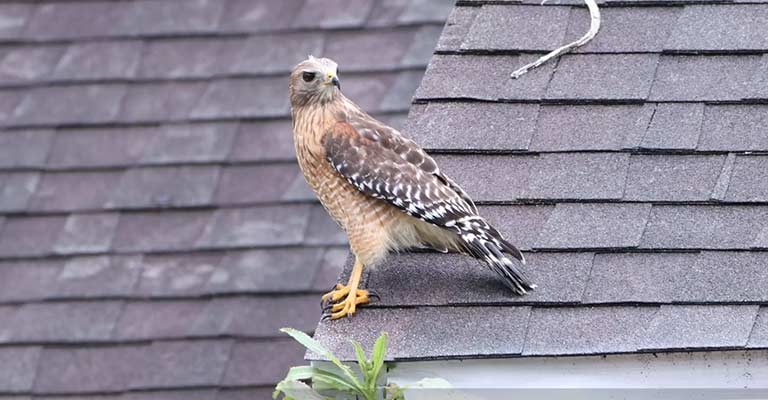
The vocalizations of the Florida Red-tailed Hawk are unique and can aid in identification. Its call is a distinctive, high-pitched scream or a series of short whistles.
Familiarizing oneself with these vocalizations can be valuable when identifying this bird in the field.
Habitat Preferences
Understanding the hawk’s habitat preferences is crucial for identification. Florida Red-tailed Hawks can be found in a variety of environments, including open woodlands, grasslands, and even urban areas.
Observing the bird in its preferred habitat can provide additional context for accurate identification.
Behavioral Traits
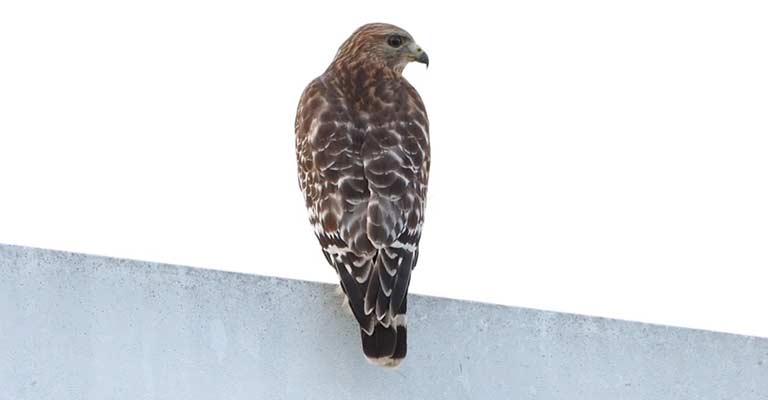
These hawks are skilled hunters, often seen perched high in trees or on utility poles, scanning the surroundings for prey.
Their hunting behavior involves soaring at great heights before making a swift descent to capture their target.
Range and Migration
While some Florida Red-tailed Hawks are year-round residents, others may migrate during the winter. Understanding their seasonal movements and range can aid in identification at different times of the year.
The Florida Red-tailed Hawk is a magnificent bird with distinct characteristics that make it stand out in the avian world.
By paying attention to size, coloration, markings, vocalizations, and habitat preferences, bird enthusiasts and naturalists can confidently identify this captivating raptor in the diverse landscapes of Florida.
Taxonomical Details of Florida Red-tailed Hawk
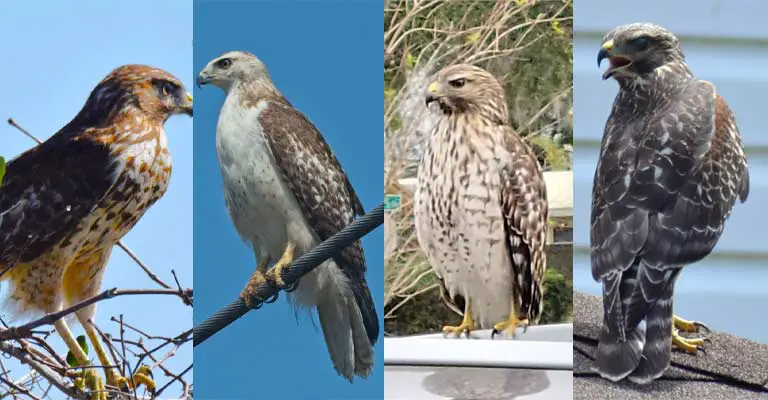
Here’s a table detailing the taxonomical details of the Florida Red-tailed Hawk (Buteo jamaicensis umbrinus):
| Taxonomic Level | Classification |
| Domain | Eukaryota |
| Kingdom | Animalia |
| Phylum | Chordata |
| Class | Aves |
| Order | Accipitriformes |
| Family | Accipitridae |
| Genus | Buteo |
| Species | B. jamaicensis |
| Subspecies | B. j. umbrinus |
These taxonomical details provide a structured classification of the Florida Red-tailed Hawk, outlining its place in the biological hierarchy from the broadest category (Domain) to the specific subspecies.
The Florida Red-tailed Hawk (Buteo jamaicensis umbrinus) belongs to the Animalia kingdom, Chordata phylum, Aves class, and Accipitriformes order.
It is a member of the Accipitridae family, characterized by its diurnal birds of prey. Within the Buteo genus, the species name is B. jamaicensis, representing the broader Red-tailed hawks.
The Florida Red-tailed Hawk is further classified as the subspecies B. j. umbrinus, emphasizing its distinct regional variation within the broader taxonomy.
This classification places the hawk in the intricate web of biodiversity, highlighting its unique role among avian species.
Florida Red-tailed Hawk Life History
The Florida Red-tailed Hawk (Buteo jamaicensis umbrinus) is a magnificent raptor that plays a crucial role in Florida’s ecosystems.
Understanding the life history of these hawks is essential for conservation efforts and appreciating their ecological significance.
This comprehensive exploration covers various aspects of their life history, from their dietary preferences to conservation concerns.
Food
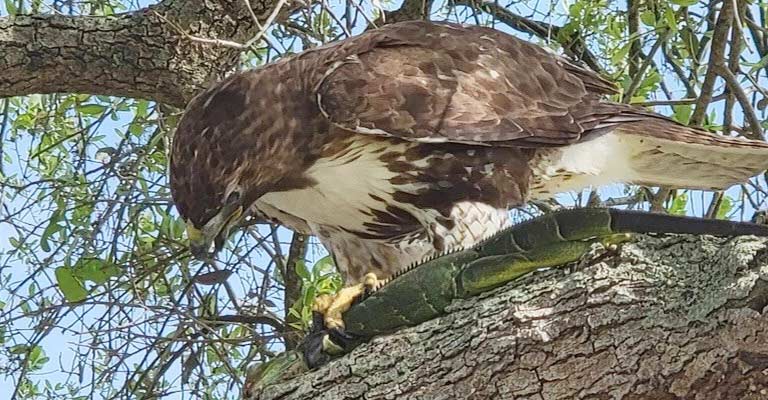
Florida Red-tailed Hawks are formidable predators with a diverse diet. Their primary food sources include small mammals like rodents, rabbits, and squirrels.
However, they are opportunistic hunters and may also prey on birds, reptiles, and even insects. Their sharp talons and powerful beaks make them adept at capturing and consuming a wide range of prey.
Habitat
These hawks are highly adaptable and can be found in various habitats across Florida. They thrive in open woodlands, grasslands, agricultural areas, and urban environments.
Their ability to adapt to diverse landscapes contributes to their widespread presence throughout the state.
Range Map
The range of the Florida Red-tailed Hawk extends across the entire state of Florida, showcasing a preference for the warm and subtropical climate.
A detailed range map indicates their distribution, illustrating their year-round residency in some areas and migratory patterns in others, particularly during winter.
Nesting
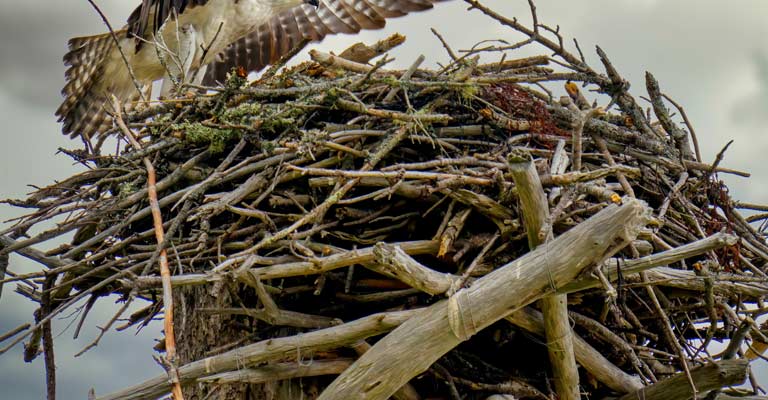
Red-tailed Hawks are known for their impressive nest-building skills. They construct large nests, often situated high in trees or on cliffs.
The nests are built with sticks, twigs, and lined with softer materials. These nests serve as breeding territories and are often used over multiple breeding seasons.
Here’s a table detailing the nesting details of the Florida Red-tailed Hawk:
| Nesting Details | Facts |
| Clutch Size | 1 to 3 eggs |
| Number of Broods | Typically 1 per breeding season |
| Egg Length | Approximately 2.5 to 2.9 inches |
| Egg Width | Approximately 1.9 to 2.2 inches |
| Incubation Period | Around 28 to 35 days |
| Nestling Period | About 42 to 46 days |
| Egg Description | Creamy-white with brown markings |
| Nest Location | High in trees or on cliffs |
| Nest Construction | Built with sticks and twigs, lined with softer materials |
| Parental Involvement | Both parents share incubation and feeding duties |
| Fledging | Chicks fledge at approximately 6 weeks old |
| Nest Reuse | Nests may be reused in successive breeding seasons |
These details provide a comprehensive overview of the nesting habits of the Florida Red-tailed Hawk, offering insights into their reproductive behavior, nesting preferences, and parental care.
Breeding
Breeding occurs in late winter and early spring. The courtship displays involve aerial acrobatics and vocalizations. Once a pair has formed, they work collaboratively to build or refurbish a nest.
The female typically lays 1 to 3 eggs, and both parents take turns incubating them. After hatching, the chicks are cared for by both parents and fledge in about six weeks.
Diseases
Red-tailed Hawks, like many birds of prey, can be susceptible to various diseases.
Avian diseases such as West Nile Virus and avian pox can affect their health. Monitoring for signs of illness, such as lethargy or changes in behavior, is crucial for timely intervention.
Treatment
In cases of illness or injury, prompt and appropriate treatment is essential. Injured or sick Red-tailed Hawks may be rehabilitated by wildlife rescue organizations.
Veterinarians and wildlife rehabilitators work to address injuries, provide medical care, and, if possible, release the birds back into their natural habitat.
Conservation
Conservation efforts are critical for the well-being of Florida Red-tailed Hawks.
Habitat preservation, protection from pesticides, and awareness campaigns to reduce human-wildlife conflicts are essential components of conservation initiatives.
Collaborative efforts between government agencies, conservation organizations, and the public are crucial for ensuring the continued existence of these majestic birds.
The life history of the Florida Red-tailed Hawk is a fascinating tapestry of adaptation, resilience, and interconnectedness with the diverse ecosystems of Florida.
By understanding and appreciating their role in the environment, we can contribute to their conservation and ensure their continued presence in the skies of the Sunshine State.
10 Amazing Facts About Florida Red-tailed Hawk
The Florida Red-tailed Hawk (Buteo jamaicensis umbrinus) is a captivating raptor that inhabits the diverse landscapes of the Sunshine State. Here are 10 amazing facts about this majestic bird:
- Distinctive Red Tail: Perhaps the most iconic feature, the Florida Red-tailed Hawk boasts a striking red tail. While the hue can vary, ranging from deep red to mottled or streaked patterns, this distinctive characteristic sets it apart from other hawks.
- Adaptability in Habitat: Red-tailed Hawks in Florida showcase remarkable adaptability, thriving in a variety of environments including open woodlands, grasslands, agricultural areas, and even urban landscapes. Their ability to coexist with humans highlights their resilience.
- Impressive Size: These hawks are sizable birds, with wingspans ranging from 3 to 4 feet. Their robust build and powerful talons make them formidable predators in the skies.
- Varied Diet: Red-tailed Hawks are opportunistic hunters with a diverse diet. While small mammals like rodents and rabbits are their primary prey, they also target birds, reptiles, and insects, showcasing their adaptability in securing food.
- Vocalizations: Their vocalizations are distinctive and include high-pitched screams and short whistles. These calls play a crucial role in communication, especially during courtship displays and territory defense.
- Impressive Nest-building Skills: Red-tailed Hawks construct large nests made of sticks and twigs, often situated high in trees or on cliffs. These nests serve as breeding territories and are used over multiple breeding seasons, showcasing their impressive nest-building skills.
- Courting Displays: During the breeding season, these hawks engage in elaborate courtship displays, involving aerial acrobatics and vocalizations. These displays strengthen pair bonds and contribute to the continuation of their species.
- Dedicated Parents: Both male and female Red-tailed Hawks actively participate in raising their young. From incubating the eggs to providing food for the chicks, their cooperative parenting contributes to the success of the next generation.
- Migratory Patterns: While some Florida Red-tailed Hawks are year-round residents, others may exhibit migratory behavior, particularly during the winter months. Understanding their seasonal movements adds to the complexity of their life history.
- Conservation Concerns: Despite their adaptability, Florida Red-tailed Hawks face conservation challenges, including habitat loss and exposure to pesticides. Conservation efforts are crucial to ensure the continued presence of these magnificent birds in the Florida skies.
The Florida Red-tailed Hawk is not only a symbol of strength and adaptability but also a fascinating species with unique traits that contribute to the ecological diversity of the region.
Wrapping Up
The Florida Red-tailed Hawk emerges as a remarkable species, captivating in its adaptability, impressive size, and unique behaviors.
From the iconic red tail to its cooperative parenting and diverse diet, these hawks play a vital role in Florida’s ecosystems.
As they navigate varied habitats and face conservation challenges, appreciating their tenacity becomes crucial for their continued existence.
The Red-tailed Hawk stands not just as a symbol of strength but as a testament to the intricate balance within the natural world. Best of luck.